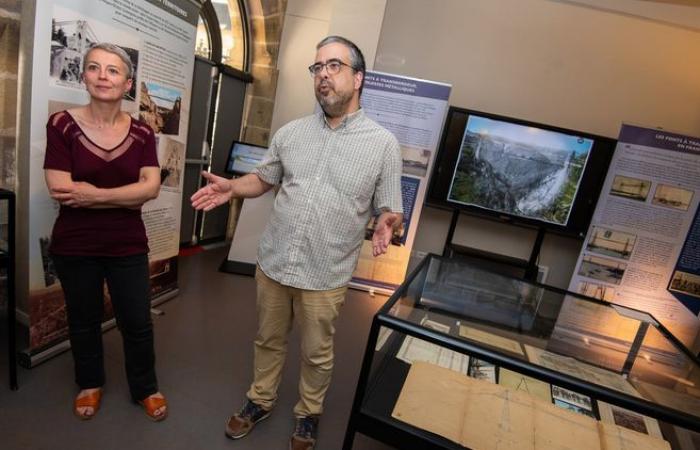
During its history, more than a century old, Gaston Leinekugel le Cocq’s Larche Metallurgical Establishments factory (Corrèze) has built hundreds of bridges around the world. The Municipal Archives of Brive trace its history.
They were visionaries and inventors, ambassadors of progress and the industrial revolution. They left in their wake metal colossi, including the Bilbao transporter bridge, listed as a UNESCO world heritage site, but also the Black Rocks viaduct in Corrèze. (read below).
Until November 15, the Municipal Archives of Brive are dedicating an exhibition to the epic tale of the Larche Metallurgical Establishments factory. It was founded in 1921 by a polytechnician and mathematician, Gaston Leinekugel Le Cocq, as a continuation of the Arnodin company, created in 1872 in Châteauneuf-sur-Loire by his father-in-law and “spiritual master”, a bridge engineer. Fernand Arnodin.
How did the Rochers Noirs viaduct, between Soursac and Lapleau, open up the Haute Corrèze?
Bridges, storiesIn 2020, the heirs of the Corrèze company donated several thousand documents, including many photos, to the Municipal Archives. Photo: Fabrice Combe
In 2020, the heirs of the Corrèze company donated several thousand documents, including a large number of photos, to the Municipal Archives, concerning the Leinekugel Le Cocq and Arnodin companies.
“This collection has a heritage value that goes beyond the department, because it concerns works built all over the world,” explains Thierry Pradel, director of the Archives. These are important contractors, known in the evolution of bridges, especially for transporter bridges, which over time have become heritage milestones and tourist attractions. »
Precisely, the companies Arnodin and Leinekugel Le Cocq have built, among others, transporter bridges in Newport, Nantes or Rochefort, but also suspension bridges in Venezuela, Argentina, Morocco, Congo, Madagascar, Syria or China .
Receive our eco newsletter by email and find out the latest news from economic players in your region.
Receive our leisure newsletter by email and find ideas for outings and activities in your region.
The highest, the most romantic
Between 1908 and 1912, the company built the Sidi M’Cid suspension bridge in Algeria, 175 metres high and 168 metres long. At the time, it was the highest bridge in the world.
A transporter bridge was built between 1896 and 1898 in Bizerte in Tunisia, within a major French naval military base. The work was dismantled in 1907 to be reassembled at the Brest arsenal.
Another work serves as a backdrop to Marcel-Pagnol’s famous trilogy. A transporter bridge, overlooking the Old Port, was built in Marseille between 1903 and 1905. It was equipped with an elevator allowing access to the deck to contemplate the magnificent panorama of the sea and the city. It even housed a restaurant. Its north pylon was destroyed in August 1944 by the German army. The rest of the bridge was demolished in September 1945.
Dramas. Two terrible tragedies affected the Leinekugel Le Cocq family. In 1931, one of Gaston Leinekugel Le Cocq’s sons, Jehan, then a young factory manager, died in the collapse of the Saint-Denis-de-Pile bridge in Gironde, at the age of 25. Another collapse, that of the Montjean-sur-Loire bridge (Maine-et-Loire) in turn undermined the financial balance of the Larche company. In 1936, the Société de constructions métalliques de la Corrèze à Larche (SCMCL) was born.
A figure of the ResistanceAt the Municipal Archives, an exhibition tells the story of an epic Corrèze story. Photo: Fabrice Combe
During the war, one of its directors, Gaston’s third son, Xavier Leinekugel le Cocq, would become a figure of the Resistance. It was he who would take over the management of the family business in 1945. He would develop an offensive strategy to conquer markets around the world, while advocating the use of a new material, aluminum.
In 1948, he lost his life with his wife and a close colleague in a plane crash. Aged 81, his father Gaston is once again elected CEO of the company. He continues his research to improve suspension bridges. In 1965, one of Xavier’s sons, Didier Leinekugel Le Cocq, took over the management of Établissements Arnodin. It will develop new activities, while continuing to exploit the properties of aluminum.
In 2002, following his departure, the Corrèze factory was purchased by the Baudin Châteauneuf company. It is the end of a family saga which had marked the construction of bridges and the Corrèze economy.
The Rochers Noirs viaduct, one of the last structures of this type in the world
It is a rigid suspension bridge, one of the last still existing in the world, built according to the patent filed in 1900 by a soldier and polytechnician, Albert Gisclard, who awarded the exclusive construction license to Fernand Arnodin’s company.
It was Gaston Leinekugel Le Cocq who supervised, between 1902 and 1907, the construction of the first suspension bridges of this type in Congo, New Caledonia and France.
A €9.8 million renovation
Built between the towns of Lapleau and Soursac, 92 metres above the Luzège River, the Rochers Noirs viaduct was inaugurated in 1913 by President Raymond Poincaré. Initially, it was a railway bridge over which the Transcorrézien line, the “Tacot”, passed between Tulle and Ussel. This line was closed on 31 December 1959. The bridge became a road bridge until 1983, then a pedestrian bridge. It was closed to traffic in 2006.
Since September 2022, a major renovation project has been launched by the Corrèze department, with the help of the Heritage Foundation and the Mission of Stéphane Bern. Its cost: €9.8 million.
Started in September 2022, this project is led by the company Baudin-Chateauneuf. On this large site, a helicopter was often used to transport and install large metal parts. The viaduct should be reopened in September 2024, after two years of work.
The extraordinary renovation project of the Rochers Noirs viaduct in Corrèze
The exhibition “Bridge Engineers, a Corrèze Adventure” is on display until November 15 at the Municipal Archives, Monday to Friday from 8:30 a.m. to noon and from 1:30 p.m. to 5 p.m. Free admission.
Dragan Perovic





